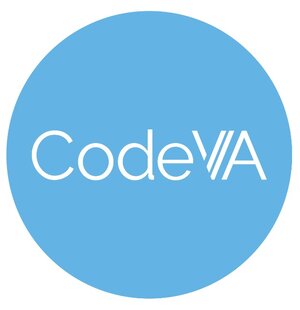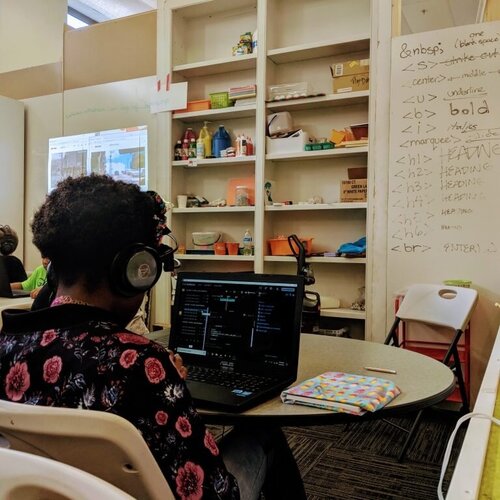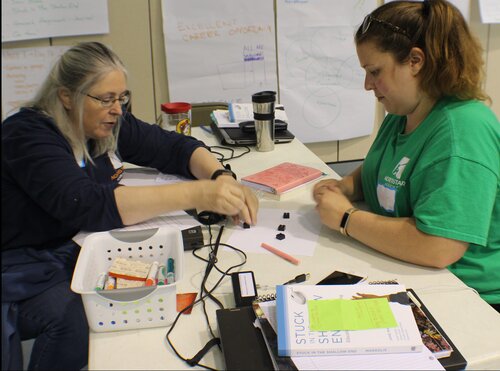
It takes a village. To get computer science into the classroom, you need resources, community support, and a plan. You need partnerships and a curriculum that will work for you and your school. This is just one example of how CodeVA in Virginia did it. Read on for inspiration as you plan your computer science implementation!


Q&A with Chris Dovi, Executive Director, and
Rebecca Dovi, Director of Education, of
CodeVA

CodeVA, a nonprofit dedicated to building computer science education, has led the charge in establishing computer science programs across the state of Virginia.We had the chance to sit down with CodeVA’s Executive Director and Director of Education, Chris and Rebecca Dovi. In this interview, they discuss CodeVA’s strategic direction, leveraging community partnerships, and replicating their approach in your own school or district.
We’re a state-funded, nonprofit program to build CS infrastructure in the state of Virginia. We train teachers to teach kids to code through advocacy, teacher professional development, direct student programs, and research. On top of that, we are an ecosystem builder for our state of Virginia.
We think of it like a stool that Virginia CS education sits on. Each of the legs of that stool, educator professional development, direct student programs, grant-funded research, and advocacy/awareness programs all are essential legs.
It’s a reflection of the importance of CS to the state of Virginia’s economy. From familiar tech companies like Amazon and Microsoft, to less obvious but massive segments of our economy like Norfolk Naval Shipyard, NASA Langley, U.S. CyCom, and other industries, VA’s economy is heavily reliant on CS.
We have other experts who chime in, but we’re really a teacher-centered organization with a faculty of over 40 classroom teachers who conduct our professional learning sessions. In fact, we provided 20,000 hours of professional training to 1,000+ teachers this past summer.
We’re making sure that computer science truly is “for all,” through an equity lens. The goal is that every child has access to a classroom where CS is happening. One other goal is to have administrators, who not only have an awareness of CS, but also an understanding of the importance of core literacy in CS and what that means to their communities.


Amazon recognized what was already happening in the state of Virginia: computer science literacy in the classroom. Having program resources like yours (Codelicious) and teachers who can use those resources is equally important. Sometimes we think spending more means solving the problem, but in CS education, not having strategy can lead to classrooms full of robots and other toys but not much computer science learning happening. Amazon and all of our many corporate and foundation partners understand that computer science literacy is more than just games; it requires teachers equipped with knowledge and understanding and administrators with clear goals. So we’re thankful for their partnership.
We were very intentional of looking at the demographics and needs of the state of Virginia. Prior to Amazon, we were a pretty lean startup, already having success. We’re helping some schools set up strategic planning processes to get caught up.

We’re Code.org’s original partner and use some of their K-5 materials as well as training for high school and middle school teachers using CS Discoveries and Code.org’s AP CS Principals training. Many of our programs, though, were developed by CodeVA, like our elementary and middle school coach academies. Other exceptions are Exploring Computer Science and Project GUTS, and like Code.org, these are also close and collaborative partnerships.
About 4 years ago we developed a train-the-trainer program called Coach’s Academy. We’ve done enough now that most places and teachers are past that 101 level, so so we now also have the capacity to allow school divisions or schools to request deep dives on specific needs.
Everything CodeVA does for teachers is free. We know what we’re building is infrastructure – equipping teachers to be confident computer science teachers, or teachers who are incorporating CS in their general education classrooms. That’s the beginning – but there has to be more. That’s where external providers come in to augment. You can’t have one without the other. Infrastructure isn’t the end all, be all.
First, teachers should be driving what their capacity for CS looks like, then they’re able to participate as school divisions, helping them make informed decisions about computer science curriculum. A blend of free and paid content is really important. Having a variety of resources with a common lexicon is really helpful for teachers to scale out their curriculum.
CodeVA is the funded part of the Virginia CS mandate law. We are free, foundational training for teachers and support services for school divisions. As we work with the state’s divisions and schools, We like to take a look at where each school is so far, and host calls to determine their best starting point. If they’ve already been teaching Scratch* or using Girls Who Code, they may have a bit of a head start. Making sure the teachers and staff have a solid awareness of what CS is and what it’s not, so they can start making smart decisions in their own planning.
First, invest in your own teachers and your own knowledge base. As teachers are building familiarity, put together a school-level planning team and make sure you have the right stakeholders who have admin authority to affect purchasing, schedule the professional learning, buy the resources, or write the curriculum. If an admin isn’t on the team, be sure someone on that team is reporting directly to an admin. CodeVA provides services to help with this planning, including a facilitated planning process for schools seeking to implement CS per the state mandate’s requirements.
Most important, though, is to allow and empower teachers to negotiate how and when these programs can be added to their already full schedules. Teacher buy-in is essential.

Quantifying results can be difficult, because schools are frequently starting from different points. We are currently working on a set of standard questions and creating tools to help schools quantify results themselves, such as number of students, access to CS, and equity. Access is the gate that gets us to equity. If you don’t have access, you can’t ever get to equity.
At an elementary level, teachers could be fearful of CS content – they might think,“Well, I’m not a computer science teacher!” but they can be, and it’s far less of a lift than many assume. For high school the idea of going from an English or a business or math teacher, to becoming a CS teacher, it may be a lack of confidence. And that’s probably at the school or district level too… it’s often all about confidence.
It’s often a completely new subject in public schools, straddling two worlds between academics and CTE. In addition, we’re trying to fit CS into existing pathways, where new pathways are going to be required. It can start with counselors not understanding how CS fits into other roles, such as science.
Think about starting with an “inventory” to see what your school already has. If you don’t have that expertise in-house, seek help. Critically consider what next steps should look like: what’s next, how it should look, and determine if there are creative ways to begin integrating CS content into existing courses, such as physics.
* Scratch is a project of the Scratch Foundation, in collaboration with the Lifelong Kindergarten Group at the MIT Media Lab. It is available for free at https://scratch.mit.edu.
Why teach computer science? There are reasons that go beyond students pursuing computer science fields or a computer science degree. In fact, we wrote a blog about the top 3 reasons students should learn computer science before high school. After reading the blog, explore our free lesson offerings! Some of our free lessons include this free computer science lesson for grades K-2 that gives students the opportunity to practice block coding and this free lesson for grades 6-8 that teaches students how webpages are built using HTML.
Along with our blogs and free lessons, Codelicious provides full-year computer science curriculum for K-12. The curriculum offers grade level differentiated learning pathways, aligns with all state and national K-12 computer science standards, and is continually updated to reflect changes in computer science. Codelicious computer science education courses are customized to districts’ unique instructional strategy for computer science in schools integration. This can mean incorporating computer science into an existing class period, adding to a specials rotation, or introducing a stand alone class. Courses are delivered with instructional resources teachers need to feel confident teaching computer science. Click here to learn more about our K-12 pathway, or read an overview below.
Our computer science curriculum for K-2 empowers you to engage your students with courses that fuel their interest. Coding lessons use ScratchJr, an introductory block coding language, perfect for emergent and early readers. In grades 3-5, inspire your students with courses that spark their creativity. Coding lessons use Scratch, a block based coding language, ideal for the transitional and fluent reader.
Our computer science curriculum middle school (6-8) helps you motivate your students with courses that connect to their world. Coding lessons use line based languages JavaScript, HTML, CSS, and Java to explore programming options.
Our computer science high school curriculum (9-12) helps you empower your students with courses that expand their skills. Coding lessons use JavaScript, Java, Python, and Godot to develop websites, programs, and games.
Explore our full course offering on our courses page to learn more about our computer science education program. Then, start a free trial of Codelicious Curriculum or schedule a 30 minute call with one of our curriculum experts.
Download a free lesson! In the lesson Treasure Map Coordinates, students will use coordinates and coordinate planes to explore the functionality of the Scratch Motion blocks with the goal of animating a sprite to move around a treasure map. This lesson is built for grades 3-5 and introduces coding for kids: Scratch, a block based coding language. The lesson plan PDF includes links to the appropriate materials and resources, a detailed procedure, activity tips, and a bonus challenge activity.